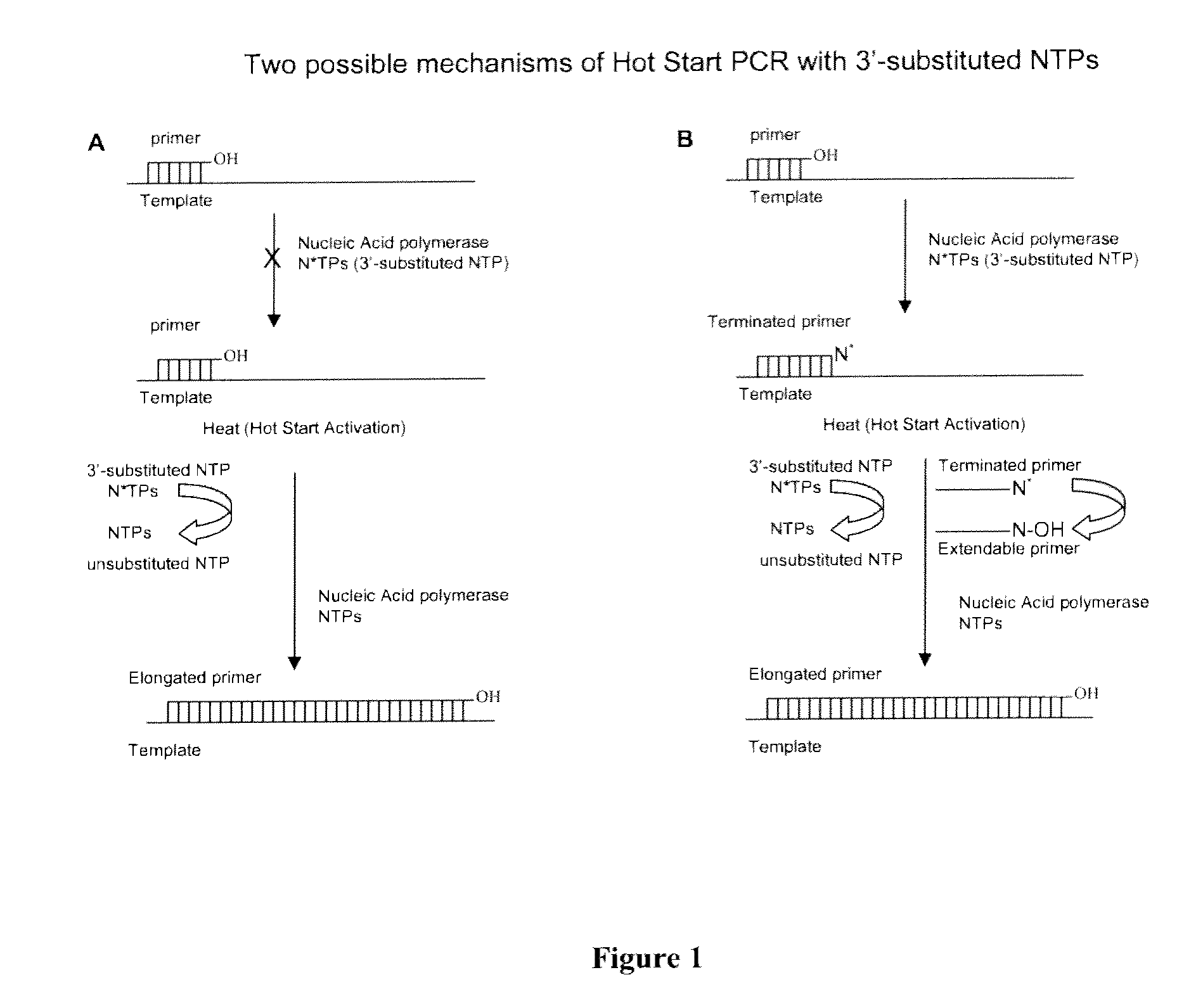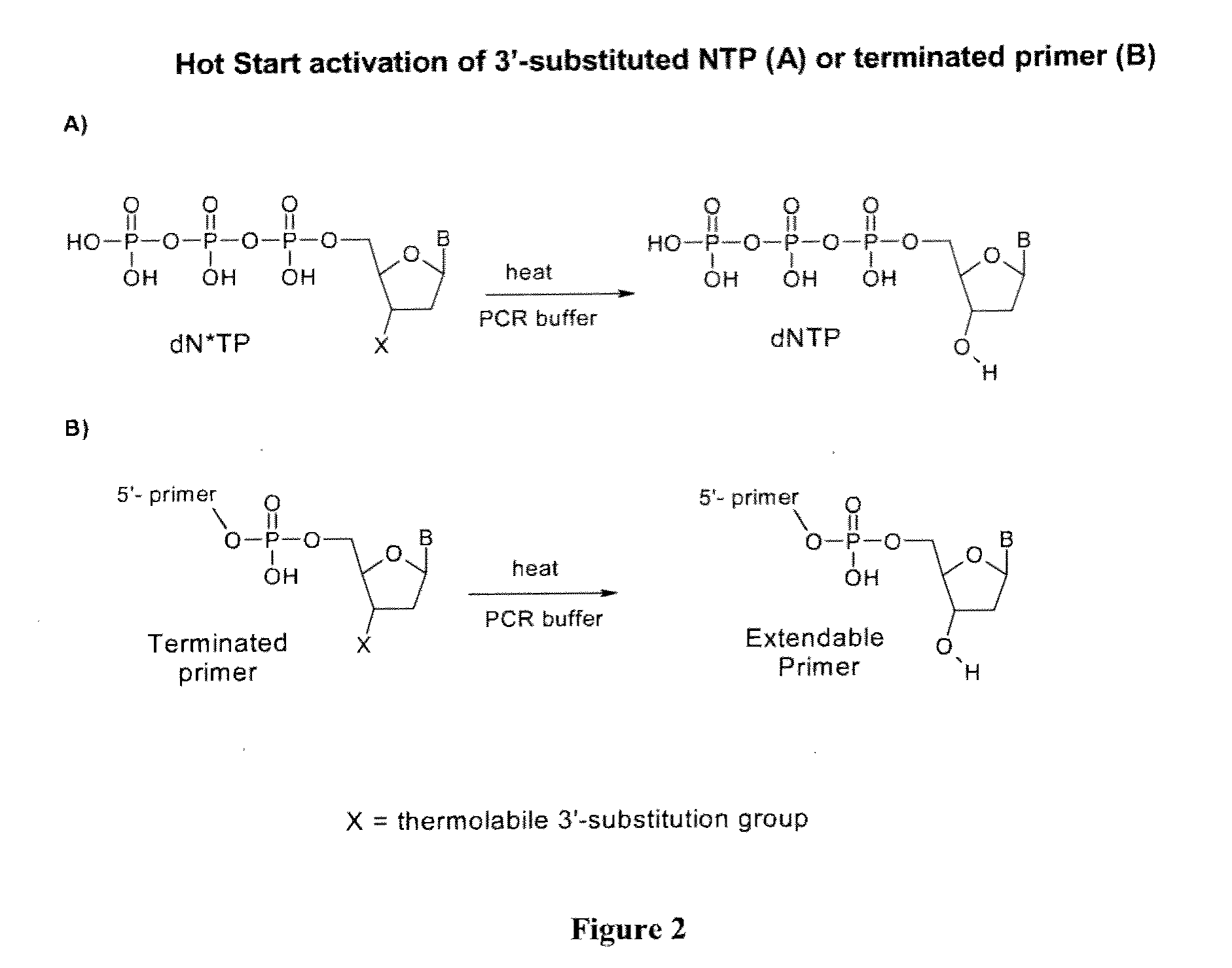Chemically modified nucleoside 5'-triphosphates for thermally initiated amplification of nucleic acid
a nucleoside and amplification technology, applied in the field of nucleic acid replication methods and compositions, can solve the problems of significant reduction of the efficiency of amplification of the desired sequence, difficult to achieve high-sensitivity analytical pcr schemes, and a much greater chance of spurious amplification products in multiplex pcr
- Summary
- Abstract
- Description
- Claims
- Application Information
AI Technical Summary
Benefits of technology
Problems solved by technology
Method used
Image
Examples
example 1
Preparation of 3′-substituted 2′-deoxyribonucleosides
[0244]Six groups were selected for 3′-substitution of dTTP: tetrahydropyranyl (THP), 4-methoxytetrahydropyranyl (MTHP), tetrahydrofuranyl (THF), acetyl (Ac), methoxyacetyl (CH3OAc) and phenoxyacetyl (PhOAc).
[0245]The 3′-ether derivatives of thymidine were synthesized according to general synthetic route as follows. First, thymidine was reacted with 1.2 equiv. of acetic anhydride in pyridine. The resulting mixture of 3′-O-acetyl, 5′-O-acetyl and 3′, 5′-O-bis-acetyl substituted thymidines was separated into individual compounds using silica gel chromatography. The isolated 5′-O-acetylthymidine was reacted with 2,3-dihydrofuran, 3,4-dihydro-2H-pyran or 5,6-dihydro-4-methoxy-2H-pyran in the presence of p-toluenesulfonic acid in dioxane for 5 hours. Subsequent treatment with methanolic ammonia to remove 5′-O-acetyl protecting group produced 3′-THF, 3′-THP or 3′-MTHP derivatives of thymidine, respectively. The 3′-THF substituted deoxyri...
example 2
5′-triphosphorylation of 3′-substituted 2′-deoxyribonucleosides
[0248]The 3′-substituted 2′-deoxynucleoside 5′-triphosphates were prepared from the 3′-ether and 3′-ester substituted 2′-deoxynucleosides according to the Ludwig-Eckstein procedure (J. Org. Chem., 54, 631-635 (1989)) as follows.
[0249]The 3′-substituted 2′-deoxynucleoside was reacted with 1.1 equiv. of 2-chloro-4H-1,3,2-benzodioxaphosphorin-4-one in dioxane-pyridine solution followed by reaction with 1.6 equiv. of tributylammonium pyrophosphate, subsequent iodine oxidation of P(III) to P(V), and a final treatment with aqueous triethylammonium bicarbonate. The resulting 3′-substituted dNTPs were isolated and purified by a combination of anion-exchange and reverse-phase chromatography to obtain 98-99% pure 3′-substituted dNTP as either sodium or potassium salt. Structures of synthesized compounds were confirmed by proton and phosphorus NMR and mass-spectrometry.
example 3
Kinetics of Conversion of dTTP Containing a 3′-Substituted Group to the Corresponding Natural dTTP
[0250]Conversion of the 3′-substituted dTTP to the corresponding unmodified dTTP was investigated in PCR buffer (pH 8.4 at 25° C., Table 1) at 20° C. and 95° C. The reactions were monitored by analysis of the incubated mixtures by reverse-phase and anion-exchange HPLC. The resultant formation of dTTP versus time at 95° C. is presented in FIG. 3. The estimated concentration of the dTTP that formed from 3′-substituted dTTP after 2, 10, and 20 minutes of incubation at 95° C. are presented in Table 1.
[0251]At room temperature (ca. 20° C.) in PCR buffer, all 3′-ether substituted dTTP were stable for at least several days. Among the 3′-ester derivatives of dTTP the 3′-O[CH3OAc] and 3′-O[PhOAc] derivatives of d TP showed 4% and 10% cleavage of the 3′-ester group, respectively, within 60 minutes of incubation in PCR buffer at room temnperature, whereas for 3′-O-[Ac] derivative of dTTP only 6% c...
PUM
| Property | Measurement | Unit |
|---|---|---|
| temperature | aaaaa | aaaaa |
| temperature | aaaaa | aaaaa |
| temperature | aaaaa | aaaaa |
Abstract
Description
Claims
Application Information
 Login to View More
Login to View More - R&D
- Intellectual Property
- Life Sciences
- Materials
- Tech Scout
- Unparalleled Data Quality
- Higher Quality Content
- 60% Fewer Hallucinations
Browse by: Latest US Patents, China's latest patents, Technical Efficacy Thesaurus, Application Domain, Technology Topic, Popular Technical Reports.
© 2025 PatSnap. All rights reserved.Legal|Privacy policy|Modern Slavery Act Transparency Statement|Sitemap|About US| Contact US: help@patsnap.com



